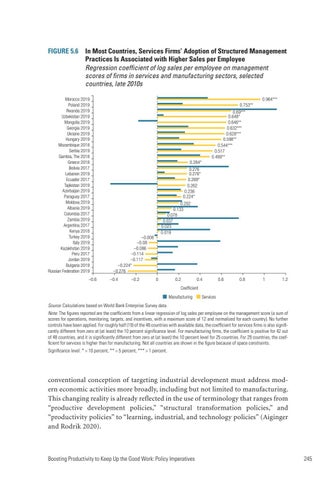FIGURE 5.6 In Most Countries, Services Firms’ Adoption of Structured Management Practices Is Associated with Higher Sales per Employee Regression coefficient of log sales per employee on management scores of firms in services and manufacturing sectors, selected countries, late 2010s Morocco 2019 Poland 2019 Rwanda 2019 Uzbekistan 2019 Mongolia 2019 Georgia 2019 Ukraine 2019 Hungary 2019 Mozambique 2018 Serbia 2019 Gambia, The 2018 Greece 2018 Bolivia 2017 Lebanon 2019 Ecuador 2017 Tajikistan 2019 Azerbaijan 2019 Paraguay 2017 Moldova 2019 Albania 2019 Colombia 2017 Zambia 2019 Argentina 2017 Kenya 2018 Turkey 2019 Italy 2019 Kazakhstan 2019 Peru 2017 Jordan 2019 Bulgaria 2019 Russian Federation 2019 –0.6
0.964*** 0.753** 0.69*** 0.648* 0.646** 0.632*** 0.628*** 0.598** 0.544*** 0.517 0.489** 0.284* 0.276 0.276* 0.269* 0.262 0.236 0.224* 0.202 0.133 0.078 0.037 0.023 0.019
–0.008 –0.08 –0.086 –0.114 –0.117 –0.224* –0.276 –0.4
–0.2
0
0.2
0.4
0.6
0.8
1
1.2
Coefficient Manufacturing
Services
Source: Calculations based on World Bank Enterprise Survey data. Note: The figures reported are the coefficients from a linear regression of log sales per employee on the management score (a sum of scores for operations, monitoring, targets, and incentives, with a maximum score of 12 and normalized for each country). No further controls have been applied. For roughly half (19) of the 48 countries with available data, the coefficient for services firms is also significantly different from zero at (at least) the 10 percent significance level. For manufacturing firms, the coefficient is positive for 42 out of 48 countries, and it is significantly different from zero at (at least) the 10 percent level for 25 countries. For 29 countries, the coefficient for services is higher than for manufacturing. Not all countries are shown in the figure because of space constraints. Significance level: * = 10 percent, ** = 5 percent, *** = 1 percent.
conventional conception of targeting industrial development must address modern economic activities more broadly, including but not limited to manufacturing. This changing reality is already reflected in the use of terminology that ranges from “productive development policies,” “structural transformation policies,” and “productivity policies” to “learning, industrial, and technology policies” (Aiginger and Rodrik 2020).
Boosting Productivity to Keep Up the Good Work: Policy Imperatives
245

